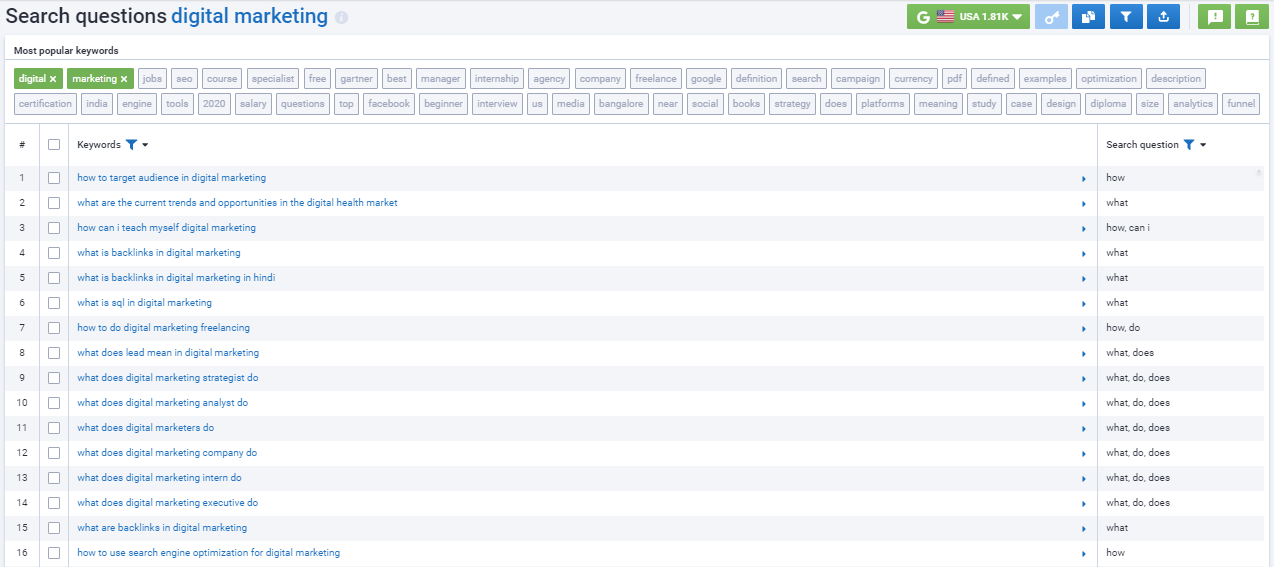Start Exploring Keyword Ideas
Use Serpstat to find the best keywords for your website
Personalization in Guest Blogging - From Prospecting to Publishing

The reason is simple; guest blogging is one of the most effective ways to boost your website’s authority, improve your rankings, and ultimately attract new visitors.
In this article, we will look at what guest blogging is and examine its main advantages for different types of businesses.
But, the main goal of this article is to analyze why a hyper-personalized approach will allow you to get amazing guest blogging opportunities and help you publish on authority websites.
How to Become a Successful Guest Blogger Through Hyper-personalized Approach
- Find Relevant Websites that Accept Guest Posts
- Identify Key Decision Makers
- Interact and Engage with Prospects Before Outreach
- Find and Verify the Contact Information of Key Decision Makers
- Research Potential Guest Post Topics Based on Prospects’ Audience and Content they Cover
- Create a Personalized Outreach Sequence
- Negotiate
- Publish & Promote
What is Guest Blogging and Why You Should Do it?
At the same time, as a guest author, you have the opportunity to create an author bio on this authoritative website. Through this bio, you can explain who you are and what you do, and of course, include valuable information about your website.
A great author bio contains the following:
- Your full name and facts you want to share with readers
- Some biographical details (job position, studies, etc)
- Credentials and references
- Information about your blog/website
- A personal touch (like a hobby, where you currently live, etc)
- 1It allows you to build a voice as an industry leader: Creating valuable content for websites relevant to your industry allows you to showcase your expertise and become a relatable micro-influencer in your niche.
- 2It helps you grow your brand and broaden your target audience: The more blog posts you produce, the more the backlinks you create leading back to your website. Do-follow links will expand your target audience and therefore grow your brand at the same time.
- 3It improves your SEO performance: Guest blogging is ultimately effective when it comes to SEO, especially if you get backlinks from websites with high domain authority.
- 4It helps you build strong relationships with important people and websites relevant to your niche: This can easily result in long-term partnerships and new co-marketing opportunities.
How to Become a Successful Guest Blogger Through Hyper-personalized Approach
This includes finding the best authoritative websites in your niche, connecting with their key decision-makers, and ultimately creating an effective pitch that’s tailored to that particular prospect.
Let’s have a look at what this means and how the following 8 simple steps will allow you to personalize and automate the process. From prospecting to publishing a guest post, nothing will be left out in this part of the article:
#1 Find Relevant Websites that Accept Guest Posts
- It is posted in a domain that’s relevant to your blog/website’s niche;
- The domain and page where your guest post is published have high authority (on a scale of 0-100);
- The website where your guest post is published has a lot of traffic;
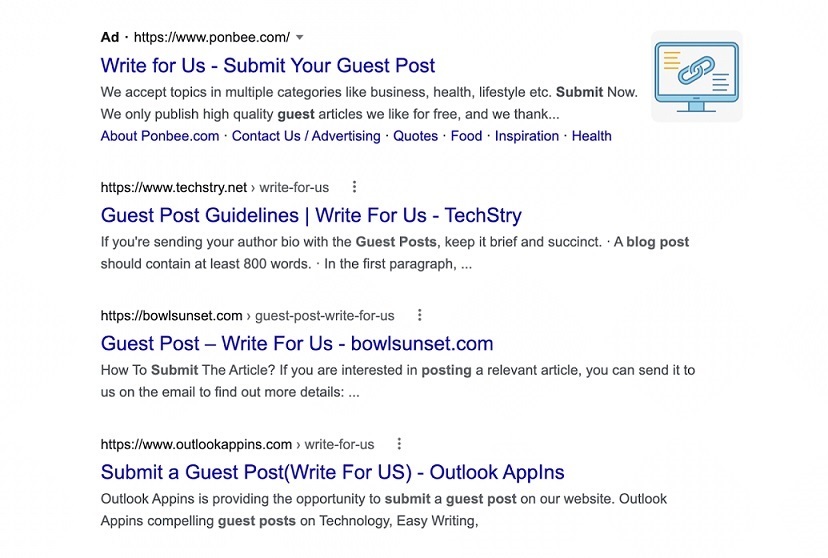
Finally, you can connect with guest bloggers and link builders through social media (e.g. LinkedIn), communication platforms like Slack, etc.
Creating a list of criteria is also very important and will allow you to filter out websites that don’t meet your needs and preferences. Generally speaking, you should always aim for relevant websites that:
- 1Accept guest posts;
- 2Have a DR (Domain Rank) and DA (Domain authority) of 70+;
- 3Have organic traffic higher than 25,000 people per month;
- 4Have a low spam score (5% or less, preferably 0%);
- 5If you own a SaaS business, aim to publish on other SaaS websites or are relevant to your industry blogs.
#2 Identify Key Decision Makers
First of all, the search filters of the platform are very helpful. All you need to do is find the official LinkedIn account of the website you want to write for. From that account, you can easily find the website’s SEO managers, Editors, Content Managers, etc.
Find persons that have content-related positions on that website and simply connect with them.
On LinkedIn, this is a pretty easy process:
- 1Visit the website’s LinkedIn page;
- 2Go to the Employees page;
- 3From the results, try to find the employees that use terms related to content in their job description (SEO, Editor, Content Strategist, and so on).
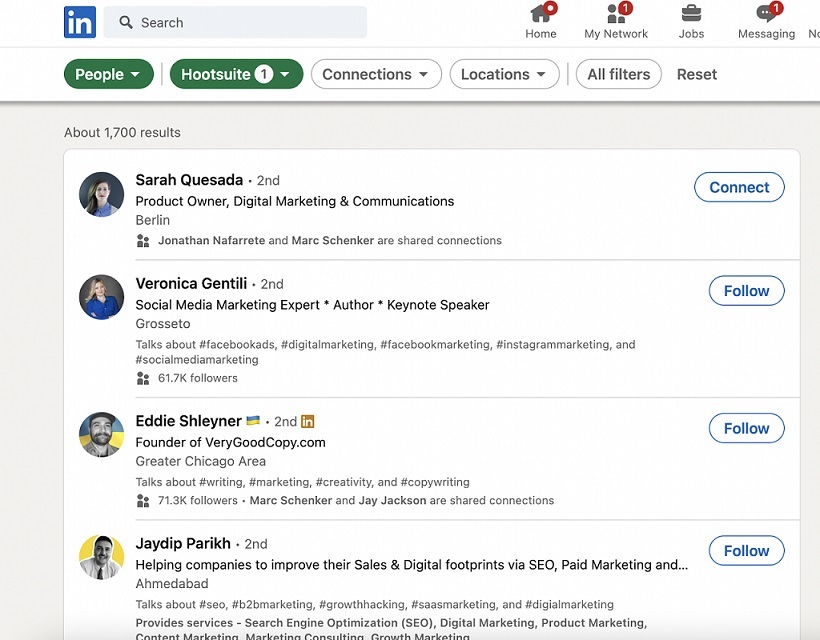
This is a crucial step of the whole process and frankly, a common mistake in guest blogging approaches. At this point, you don’t want to instantly proceed to the outreach stage. Instead, it is time to interact and engage with prospects.
#3 Interact and Engage with Prospects Before Outreach
Once you’ve connected with the key decision-makers of a website on LinkedIn, you can start building this relationship. You can start by interacting and engaging with their LinkedIn or Twitter posts. Getting to know the person behind the job position is not only gentle but also an effective strategy that will come in handy once you get into the outreach stage.If you want to do it at scale, you can also use LinkedIn automation tools that allow you to automate the contact request, personalization, profile visits and drip messages.
The same is true for blog posts. For example, if one of the key decision-makers you have identified just posted a new blog post, read it carefully and share your honest opinion with them. This may sound like a lot of work, and it is. But, if you want to aim for authoritative, high-quality websites, it is something that needs to be done.
You can think of this bonding process as the initial step of your outreach. Once you’ve built an initial relationship with your prospects, it is time to collect and verify their contact information.
#4 Find and Verify the Contact Information of Key Decision Makers
- Found the best websites that have high DR and accept guest posts.
- Identified the key decision-makers of such websites on LinkedIn and/or Twitter.
- Interacted with prospects on social media and blogs.
Usually, key decision-makers include their email addresses on their LinkedIn and Twitter profiles. But, such email addresses aren’t always valid. To avoid sending a personalized, well-crafted pitch to an invalid email you should always perform email verification to ensure your emails get delivered.
On the flip side, if your prospect doesn’t include their email address on social media, you can either ask them for it or use an email address lookup tool. Such an online tool is very easy to use. In fact, the only information you need is your prospect’s full name and their domain name (where your guest post will be published).
For example, if you want to write a blog post for, let’s say the Hunter blog, you can simply find the prospect’s full name (e.g. Irina Maltseva) and add the hunter.io into the domain name.
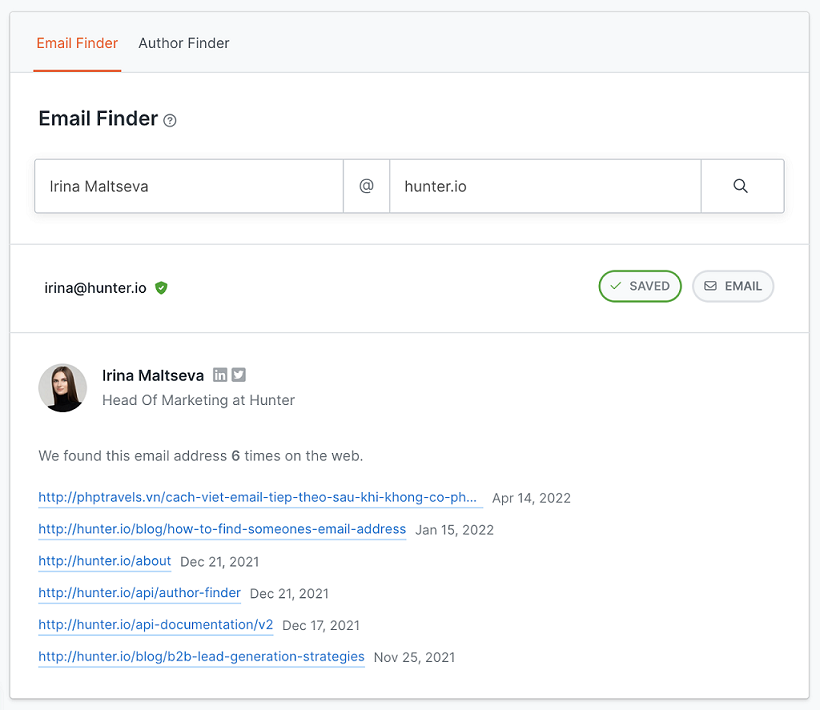
#5 Research Potential Guest Post Topics Based on Prospects’ Audience and Content they Cover<H3> Підзаголовок
Start by visiting the website you want to write for. Have a look at the content they cover and spend some time understanding their target audience’s main interests and values. At the same time, seek the main keywords their blog is aiming at when it comes to SEO and create a list of possible topics that you could write about.
Let’s explain that with an example. If the guest website is all about SEO tactics and you can add value by combining that with your website’s services, which is about digital marketing automation software, this is where your pitch should aim at.
In any case, you should opt for topics that aren’t saturated on the website you are about to write a guest post for. Once you’ve come up with a few topic ideas it is time to polish them and share them with your prospects.
Another smart thing to do in this step is to find the technical requirements the website has when it comes to guest posts. Usually, these include:
- Specific word count (i.e. 1000+ words);
- Tone (friendly, business, authoritative, etc.);
- Internal and external linking;
- Backlinks.
In a few words, you should always make sure that the topics you come with:
- Don’t already exist on the prospect’s website;
- Have a high SEO value (include keywords that drive a lot of traffic);
- Match the website’s audience values and interests;
- Are relevant to your website content and your area of expertise.
#6 Create a Personalized Outreach Sequence
We have already explored how sharing your top topic ideas is the best way to contact a prospect. You can also use links to your blog or website and showcase your best content. This way you can ensure that the prospect gets an overall idea of your expertise and understand what your webpage is all about.
At the same time, you should treat the personalization of your pitch as a series of specific steps. First of all, you can utilize some of the best cold email templates. This is a smart way to craft your own pitch from scratch, depending on the decision-makers you are about to contact and their website.
Let’s start with the subject line. It is crucial for your subject line to be short, urgent, and personalized. You need your email’s subject to explain exactly what your pitch is all about, but also help the prospect understand that this isn’t a spammy email and thus a waste of time. The same is true for follow-up emails to prospects that didn’t respond after your initial contact.
Your subject line could look something like this: Hey (John), it’s (Mark) from (your website) | Link Building and Content Creation for (their website).
Ok, now you’re done with the subject line, and it’s time to start crafting a personalized email. In this stage, you can think of all the data you’ve gathered during your initial relationship with this prospect on social media and utilize them. For example, if you’ve had interesting discussions with this person for a while on LinkedIn, make sure to mention it.
Here are a few tips on how to personalize cold emails:
- 1If you are looking for a blog owner’s email using a dedicated service, most likely the tool will show the name of all company members as well as emails. So, use the prospect’s name in the beginning: “Hello Name”, for example, Hello John.
- 2Mention where you found their email, for instance, I read your article on Forbes about B2B sales and it’s very helpful.
- 3Mention some tools that they use on their website: I saw you are using Hotjar on your site, do you find it useful?
- 4You need to do some research on the blog beforehand and find content relevant to your niche. Say something about their prominent post, for example, I read your article about email automation, great job on this piece of content! Or write something more specific about the article to show that you really read it.
- 5Prove you did a research about the company, maybe they were featured in the news: Great work on getting a 5-star rating on Glassdoor!
- 6Bring your relevant case studies: I worked with the (company name) and helped them bring 10% more traffic to the site with Facebook Ads.
This is a smart way to personalize the outreach sequence even more and increase your response rate.
Let’s take a look at a few email templates and discuss why they work:
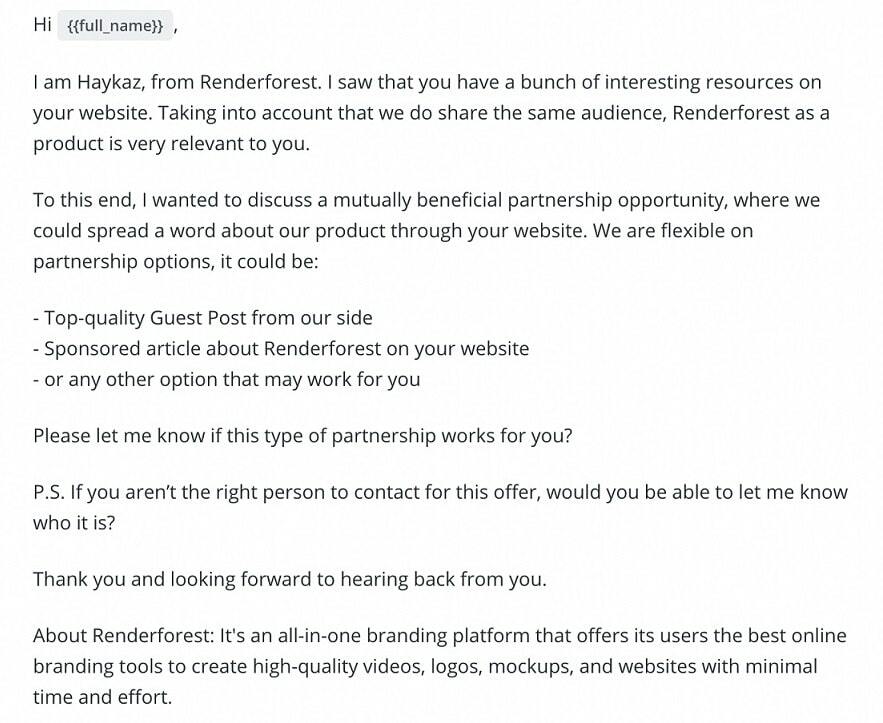
- It’s personalized;
- The person tells that these companies share the same audience or their services/products are similar;
- They offer flexible partnerships;
- They explain what their company does at the end of the email.
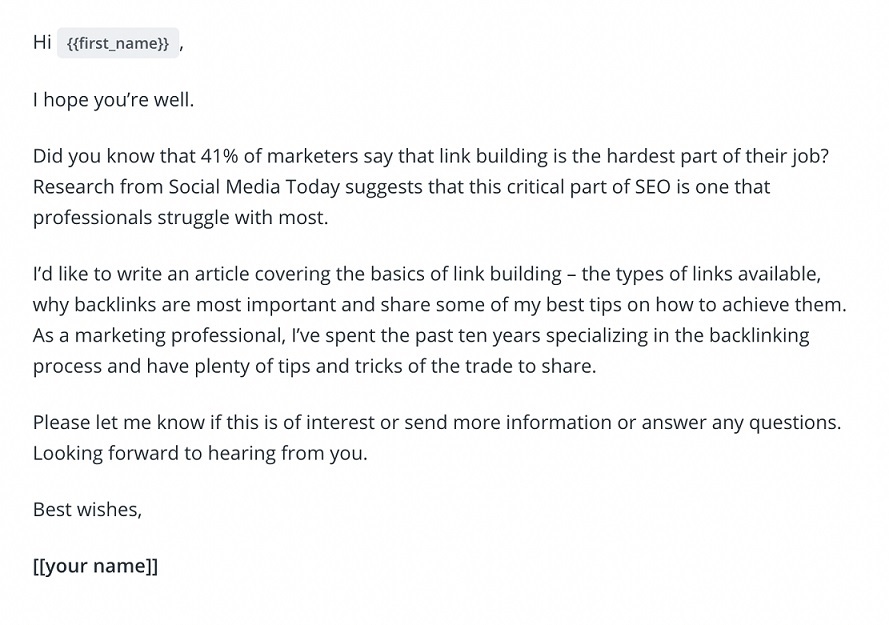
- The email asks about the relevant problem of all businessmen - it’s link building;
- Asking questions is a good idea to make someone reply;
- Featuring statistics means a persona did research and knows the topic. It’s proof of your expertise;
- Talking about your experience is also a good point.
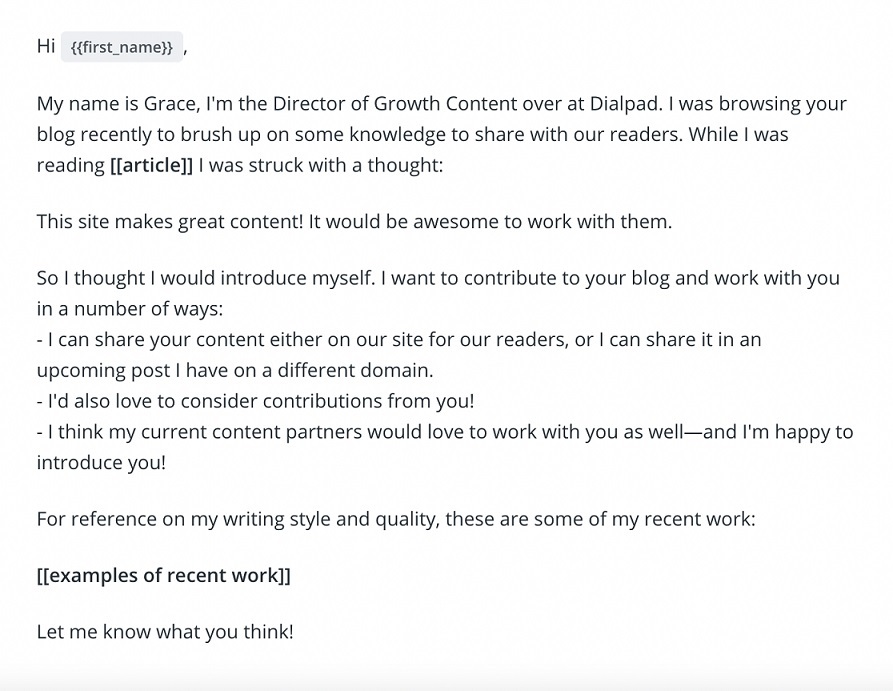
- A person mentions an actual article from the blog and says that they love their content and find it helpful;
- A person offers a few ways for the future cooperation;
- It shows that current content partners would be glad to work with the company.
#7 Negotiate
On the contrary, most prospects appreciate it when you provide them with an outline of your blog post. Let’s explain that with an example: Suppose your prospect really loved a topic idea you suggested. Yet, their website’s guest post requirements mention that the accepted length is between 1000 and 1500 words.
If you think that your blog post needs to be longer for the topic to be fully covered, let your prospect know. Accordingly, say that the guest website accepts only 1 backlink per guest post. If you believe that 2 of your website’s blog posts will be really valuable for this topic and they need to be included, explain why and negotiate about it.
By the end of your negotiation, you should have a comprehensive list of everything that you have to take care of and include in your guest post.
Guest blogging: main technical requirements to be discussed before publishing:
- Word count;
- Tone (friendly, business, authoritative, etc.);
- Number of internal links;
- Number of authority/external links;
- Number of backlinks;
- Tone of voice;
- Target audience;
- Visuals and Graphics (e.g. images, infographics, etc);
- Tables, bullet lists, numbered lists.
#8 Publish & Promote
- 1The technical requirements;
- 2The expertise needed to write the piece;
- 3Data about the blog’s audience;
- 4Keyword research and link-building strategy.
- Create an outline to make sure that the result meets the word count requirements you discussed with the prospect;
- Make sure that the blog post is broken into headings and small paragraphs;
- Optimize your content for SEO (include keywords, quotes, lists, and so on);
- Insert the links needed (internal, external, backlinks);
- Include visuals and graphics;
- Proofread and double-check your content before you submit it.
Yet, after your article is published, the guest blogging sequence doesn’t have to stop there. On the contrary, a brilliant tactic is to promote your guest post on different social channels and therefore build some new backlinks. Utilizing social media marketing is a must during this step.
Make sure to promote your guest post on your Twitter, LinkedIn, and Facebook accounts. On the same account, you can share the link of your guest post on forums, other blogs, and so on. This won’t only allow your guest post to attract more visitors but it is also the perfect way to build long-term relationships with editors.
Wrapping up
In 2022, more than half of content marketing strategies focus on improving the quality of the content. And that’s reasonable, considering how competitive the market (and therefore ranking) has become. Still, don’t be afraid of the mistakes you might make in the beginning. Noone created the perfect pitch or the best guest post instantly. Guest blogging is a complicated process. Yet, as with most SEO-related strategies, practice makes perfect!
Speed up your search marketing growth with Serpstat!
Keyword and backlink opportunities, competitors' online strategy, daily rankings and SEO-related issues.
A pack of tools for reducing your time on SEO tasks.
Discover More SEO Tools
Text Analysis Tool
Unlock the power of your text data with our advanced Text Analytics Tools
AI Content Detection
Ai Content Checker – realize if the text is AI-generated
AI Text Generator
Try our AI Content Writer tool and streamline your content creation process
AI Content Tools
AI Content Marketing Tools – simplify and optimize the content creation process
Recommended posts
Cases, life hacks, researches, and useful articles
Don’t you have time to follow the news? No worries! Our editor will choose articles that will definitely help you with your work. Join our cozy community :)
By clicking the button, you agree to our privacy policy.

